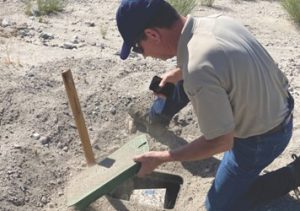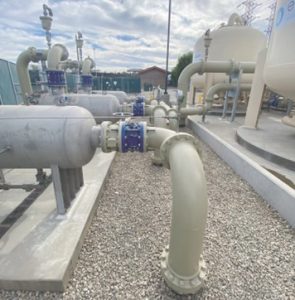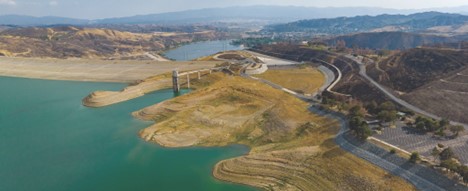SCV Water and its customers are working together to weather the historic drought facing the State of California and the Santa Clarita Valley (SCV).
SCV Water’s approach is two-fold: Investing in and protecting a diverse water supply; and working with customers in using water wisely.
PLANNING YESTERDAY FOR WATER TOMORROW
Before the first reports of widespread drought conditions began, SCV Water had been building a diverse and resilient portfolio of water supplies. These historical investments in supply, storage and treatment have played a critical role in providing some security against the severe drought.
Imported Water
In the 1960s, the community recognized additional water would be needed to supplement local supplies, and contracted with the State of California for water from the State Water Project. SCV Water continues to invest in maintenance and upgrades to the distribution and storage network for that supply. Over the years, SCV Water has invested in additional amounts of State Water Project water to better meet the needs of a growing community. Further investment in other water rights and water banking (more on these below) strengthen the long-term reliability of the imported supply portfolio. In dry years, like the area is experiencing now, SCV Water imports about 7 percent of the total supply from the State Water Project, compared to about 50 percent in a normal water year.
Since this supply fluctuates in years of drought and may be uncertain after a disaster like a large earthquake, the Agency has proactively invested in local water supplies to ensure SCV Water customers have a secure, reliable water source.

Principal Water Resource Planner Rick Viergutz checks equipment that monitors conditions for Groundwater Dependent Ecosystems, as part of the Groundwater Sustainability Plan.
Local Groundwater
The Santa Clarita Valley is fortunate to overlie two main groundwater aquifers, which can provide a local, less expensive, and more reliable alternative to imported water to fill part of the community’s annual water needs. About half of the SCV’s water supply in a typical year would come from groundwater; however, it has been reduced to about 37 percent this year.
Portions of the aquifers have experienced contamination from industrial activities and man-made chemicals. The cause of this reduction began before the current drought, and SCV Water has an aggressive treatment program underway to protect and restore the groundwater.
Of SCV Water’s 42 active wells, 17 are removed from service due to contamination from per- and polyfluoroalkyl (PFAS) chemicals. In the last few years, SCV Water strategically and nimbly built two treatment facilities, with several more in process to increase groundwater supply. Several other wells have been impacted by contaminants including perchlorate and volatile organic compounds from the Whittaker Bermite property, a former munitions testing and manufacturing site. Treatment systems have been installed for some wells, and others are undergoing design of new treatment facilities to bring them back into service.
Banked Water and Other Dry-Year Reserves
The Agency’s most innovative and valuable investment right now is in water banking programs. SCV Water had the foresight to invest in off-site “water banks” in neighboring Kern County. Much like a savings account for money, water is added during wet years and pumped back out when needed during dry years. SCV Water recently invested in additional infrastructure that increased the amount that can be withdrawn each year. These supplies are critical to lessening the impact of a multi-year drought on the community. The Agency expects to invest in additional water storage projects in the future as part of a long-term strategy for a reliable and sustainable water supply.
Recycled Water
SCV Water has delivered recycled water to the community since 2003. Unlike groundwater, which can be depleted, or State Water Project water, which is costly and uncertain, recycled water is available as long as wastewater is generated. Several projects are underway to expand capacity almost 20-fold, from 475 up to 8,500 acre-feet per year (just under 3 billion gallons), delivering it to additional large landscape irrigation and industrial users.
In an innovative partnership between SCV Water, the City of Santa Clarita, and the developers of Vista Canyon, a new mixed-use development, a water recycling facility built by the developer will soon provide water for irrigation within Vista Canyon, as well as future landscape customers in the area. At build-out, the project could produce about 392,000 gallons per day.
“A diverse water supply is key to helping our customers weather dry years,” said SCV Water’s General Manager Matt Stone. “Investments in projects such as off-site storage options across the state, local groundwater management and water recycling ensure our customers always have access to safe, reliable water when needed.”
WATER-WISE ACTIONS

Santa Clarita home, after taking part in the Lawn Replacement Program
A strong partnership with customers recognizes that everyone has a vital role as water stewards to ensure the SCV has enough water now and in the future. Customer vigilance, coupled with robust communications and rebate programs, resulted in an 18 percent decrease in water use in September 2022 over 2020 in the Santa Clarita Valley.
“More than half of the water used in the average SCV household is used outdoors,” said Stone. “And as much as half of that water may be lost to run-off or overspray. Our innovative programs provide resources that allow customers to make small but lasting changes to water use and increase our water savings.”
SCV Water is home to many water-saving programs, rebates and resources for its residential and commercial customers. When customers asked for flexibility, the Agency delivered. Take, for instance, the Agency’s revamped Lawn Replacement Program (LRP). The new guidelines offer increased economic incentives, bonuses for native plants, options for irrigation upgrades and an expanded list of eligible project areas and sizes.
Information on water- and money-saving options accessible to customers can be found at https://yourSCVwater.com/save-water-money/.
From investing in a diverse water supply, using water wisely and restoring local groundwater, SCV Water is poised to meet the community’s water needs for years to come. Like the adage that recommends against putting all your eggs in one basket, SCV Water consistently invests in multiple sources of water, to help ensure water supplies in wet or dry years.
“Dry times in California are part of the norm. Thanks to a solid foundation of thoughtful planning and innovative projects and programs, SCV Water is here and ready to provide our customers with a long-term water supply,” said Stone. “And we couldn’t do it without the diligence of our customers in making permanent changes in water-use habits.”

Treatment facility opened in 2021, which removes PFAS from 3 groundwater wells in the area.
WHAT ARE PFAS CHEMICALS?
Synthetic PFAS chemicals have been around for more than 70 years, and are found in thousands of everyday products, including non-stick cookware, shampoo, food wrappers and firefighting foam. The chemicals have existed in the environment due to manufacturing, product use and discharges from local wastewater treatment plants.

